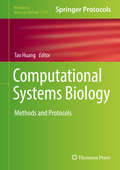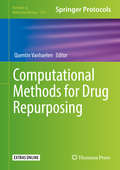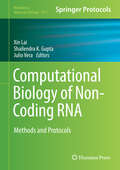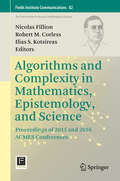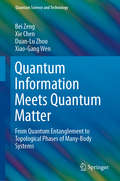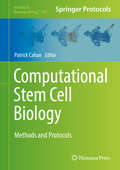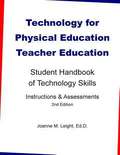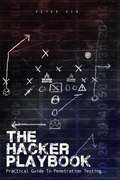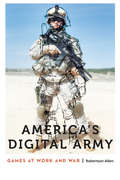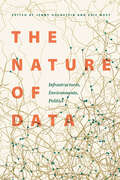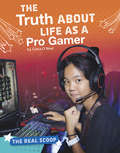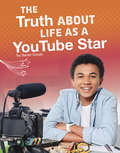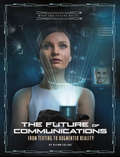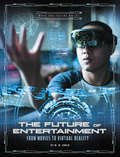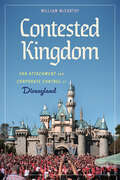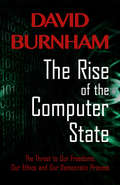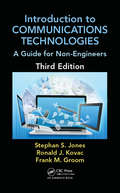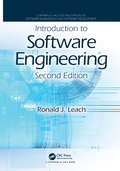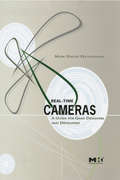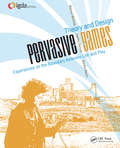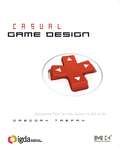- Table View
- List View
Computational Systems Biology: Methods And Protocols (Methods In Molecular Biology #1754)
by Tao HuangThis volume introduces the reader to the latest experimental and bioinformatics methods for DNA sequencing, RNA sequencing, cell-free tumour DNA sequencing, single cell sequencing, single-cell proteomics and metabolomics. Chapters detail advanced analysis methods, such as Genome-Wide Association Studies (GWAS), machine learning, reconstruction and analysis of gene regulatory networks and differential coexpression network analysis, and gave a practical guide for how to choose and use the right algorithm or software to handle specific high throughput data or multi-omics data. Written in the highly successful Methods in Molecular Biology series format, chapters include introductions to their respective topics, lists of the necessary materials and reagents, step-by-step, readily reproducible laboratory protocols, and tips on troubleshooting and avoiding known pitfalls.Authoritative and cutting-edge, Computational Systems Biology: Methods and Protocols aims to ensure successful results in the further study of this vital field.
Oceanographic Analysis with R
by Dan E. KelleyThis book presents the R software environment as a key tool for oceanographic computations and provides a rationale for using R over the more widely-used tools of the field such as MATLAB. Kelley provides a general introduction to R before introducing the ‘oce’ package. This package greatly simplifies oceanographic analysis by handling the details of discipline-specific file formats, calculations, and plots. Designed for real-world application and developed with open-source protocols, oce supports a broad range of practical work. Generic functions take care of general operations such as subsetting and plotting data, while specialized functions address more specific tasks such as tidal decomposition, hydrographic analysis, and ADCP coordinate transformation. In addition, the package makes it easy to document work, because its functions automatically update processing logs stored within its data objects. Kelley teaches key R functions using classic examples from the history of oceanography, specifically the work of Alfred Redfield, Gordon Riley, J. Tuzo Wilson, and Walter Munk. Acknowledging the pervasive popularity of MATLAB, the book provides advice to users who would like to switch to R. Including a suite of real-life applications and over 100 exercises and solutions, the treatment is ideal for oceanographers, technicians, and students who want to add R to their list of tools for oceanographic analysis.
Computational Methods for Drug Repurposing (Methods in Molecular Biology #1903)
by Quentin VanhaelenThis detailed book explores techniques commonly used for research into drug repurposing, a well-known strategy to find alternative indications for drugs which have already undergone toxicology and pharma-kinetic studies but have failed later stages during the development, via computational methods. Thereby, it addresses the intense challenges of identifying the appropriate type of algorithm and relevant technical information for computational repurposing. Written for the highly successful Methods in Molecular Biology series, the authors of each chapter use their experience in the field to describe the implementation and successful use of a specific repurposing method thus providing lab-ready instruction. Authoritative and practical, Computational Methods for Drug Repurposing serves as an ideal guide to researchers interested in this vital area of drug development.
Computational Biology of Non-Coding RNA: Methods and Protocols (Methods in Molecular Biology #1912)
by Julio Vera Xin Lai Shailendra K. GuptaThis volume details a collection of state-of-art methods including identification of novel ncRNAs and their targets, functional annotation and disease association in different biological contexts. Chapters guide readers through an overview of disease-specific ncRNAs, computational methods and workflows for ncRNA discovery, annotation based on high-throughput sequencing data, bioinformatics tools and databases for ncRNA analyses, network-based methods, and kinetic modelling of ncRNA-mediated gene regulation. Written in the highly successful Methods in Molecular Biology series format, chapters include introductions to their respective topics, lists of the necessary materials and reagents, step-by-step, readily reproducible laboratory protocols, and tips on troubleshooting and avoiding known pitfalls. Authoritative and cutting-edge, Computational Biology of Non-Coding RNA: Methods and Protocols aims to provide a state-of-the-art collection of computational methods and approaches that will be of value to researchers interested in ncRNA field.
Algorithms and Complexity in Mathematics, Epistemology, and Science: Proceedings of 2015 and 2016 ACMES Conferences (Fields Institute Communications #82)
by Ilias S. Kotsireas Robert M. Corless Nicolas FillionACMES (Algorithms and Complexity in Mathematics, Epistemology, and Science) is a multidisciplinary conference series that focuses on epistemological and mathematical issues relating to computation in modern science. This volume includes a selection of papers presented at the 2015 and 2016 conferences held at Western University that provide an interdisciplinary outlook on modern applied mathematics that draws from theory and practice, and situates it in proper context. These papers come from leading mathematicians, computational scientists, and philosophers of science, and cover a broad collection of mathematical and philosophical topics, including numerical analysis and its underlying philosophy, computer algebra, reliability and uncertainty quantification, computation and complexity theory, combinatorics, error analysis, perturbation theory, experimental mathematics, scientific epistemology, and foundations of mathematics. By bringing together contributions from researchers who approach the mathematical sciences from different perspectives, the volume will further readers' understanding of the multifaceted role of mathematics in modern science, informed by the state of the art in mathematics, scientific computing, and current modeling techniques.
Quantum Information Meets Quantum Matter: From Quantum Entanglement to Topological Phases of Many-Body Systems (Quantum Science and Technology)
by Bei Zeng Xie Chen Duan-Lu Zhou Xiao-Gang WenThis book approaches condensed matter physics from the perspective of quantum information science, focusing on systems with strong interaction and unconventional order for which the usual condensed matter methods like the Landau paradigm or the free fermion framework break down. Concepts and tools in quantum information science such as entanglement, quantum circuits, and the tensor network representation prove to be highly useful in studying such systems. The goal of this book is to introduce these techniques and show how they lead to a new systematic way of characterizing and classifying quantum phases in condensed matter systems. The first part of the book introduces some basic concepts in quantum information theory which are then used to study the central topic explained in Part II: local Hamiltonians and their ground states. Part III focuses on one of the major new phenomena in strongly interacting systems, the topological order, and shows how it can essentially be defined and characterized in terms of entanglement. Part IV shows that the key entanglement structure of topological states can be captured using the tensor network representation, which provides a powerful tool in the classification of quantum phases. Finally, Part V discusses the exciting prospect at the intersection of quantum information and condensed matter physics – the unification of information and matter. Intended for graduate students and researchers in condensed matter physics, quantum information science and related fields, the book is self-contained and no prior knowledge of these topics is assumed.
Computational Stem Cell Biology: Methods and Protocols (Methods in Molecular Biology #1975)
by Patrick CahanThis volume details methods and protocols to further the study of stem cells within the computational stem cell biology (CSCB) field. Chapters are divided into four sections covering the theory and practice of modeling of stem cell behavior, analyzing single cell genome-scale measurements, reconstructing gene regulatory networks, and metabolomics. Written in the highly successful Methods in Molecular Biology series format, chapters include introductions to their respective topics, lists of the necessary materials and reagents, step-by-step, readily reproducible laboratory protocols, and tips on troubleshooting and avoiding known pitfalls.Authoritative and cutting-edge, Computational Stem Cell Biology: Methods and Protocols will be an invaluable guide to researchers as they explore stem cells from the perspective of computational biology.
High-Throughput Metabolomics: Methods and Protocols (Methods in Molecular Biology #1978)
by Angelo D'AlessandroThis detailed volume focuses on recent technological, computational, and biostatistical advances in the field of high-throughput metabolomics. Chapters encompass methods, platforms, and analytical strategies for steady state measurements and metabolic flux analysis with stable isotope-labeled tracers, in biological matrices of clinical relevance and model organisms. Mass spectrometry-based or orthogonal methods are discussed, along with computational and statistical methods to address data sparsity in high-throughput metabolomics approaches. As a part of the highly successful Methods in Molecular Biology series, chapters include introductions to their respective topics, lists of the necessary materials and reagents, step-by-step, readily reproducible laboratory protocols, and tips on troubleshooting and avoiding known pitfalls. Authoritative and practical, High-Throughput Metabolomics: Methods and Protocols provides tools that can bring about the next generation of clinical biochemistry in a cost-effective, rigorous fashion, exponentially advancing our capacity to investigate nature while hastening the advent of personalized medicine.
Virtual Reality for Psychological and Neurocognitive Interventions (Virtual Reality Technologies for Health and Clinical Applications)
by Stéphane Bouchard Albert “Skip” RizzoThis exciting collection tours virtual reality in both its current therapeutic forms and its potential to transform a wide range of medical and mental health-related fields. Extensive findings track the contributions of VR devices, systems, and methods to accurate assessment, evidence-based and client-centered treatment methods, and—as described in a stimulating discussion of virtual patient technologies—innovative clinical training. Immersive digital technologies are shown enhancing opportunities for patients to react to situations, therapists to process patients’ physiological responses, and scientists to have greater control over test conditions and access to results. Expert coverage details leading-edge applications of VR across a broad spectrum of psychological and neurocognitive conditions, including: Treating anxiety disorders and PTSD.Treating developmental and learning disorders, including Autism Spectrum Disorder,Assessment of and rehabilitation from stroke and traumatic brain injuries.Assessment and treatment of substance abuse.Assessment of deviant sexual interests.Treating obsessive-compulsive and related disorders.Augmenting learning skills for blind persons. Readable and relevant, Virtual Reality for Psychological and Neurocognitive Interventions is an essential idea book for neuropsychologists, rehabilitation specialists (including physical, speech, vocational, and occupational therapists), and neurologists. Researchers across the behavioral and social sciences will find it a roadmap toward new and emerging areas of study.
Technology for Physical Education Teacher Education: Student Handbook of Technology Skills Instructions & Assessments
by Joanne M. LeightThis second edition handbook introduces technology skills used by effective Physical Educators in the gymnasium and health classroom, and it can easily be adapted to the needs of other educators. Designed to be used sequentially or as stand-alone lessons, the handbook's units present experiential assignments aimed at increasing user competency with such commonly available technology as Google Applications, Microsoft Office software, Web 2.0 innovations, Social Media and more.
The Hacker Playbook: Practical Guide to Penetration Testing
by Peter KimWritten by a longtime security professional and CEO of Secure Planet, LLC, this step-by-step guide to the “game” of penetration hacking features hands-on examples and helpful advice from the top of the field.
America's Digital Army: Games at Work and War (Anthropology of Contemporary North America)
by Robertson AllenAmerica’s Digital Army is an ethnographic study of the link between interactive entertainment and military power, drawing on Robertson Allen’s fieldwork observing video game developers, military strategists, U.S. Army marketing agencies, and an array of defense contracting companies that worked to produce the official U.S. Army video game, America’s Army. Allen uncovers the methods by which gaming technologies such as America’s Army, with military funding and themes, engage in a militarization of American society that constructs everyone, even nonplayers of games, as virtual soldiers available for deployment.America’s Digital Army examines the army’s desire for “talented” soldiers capable of high-tech work; beliefs about America’s enemies as reflected in the game’s virtual combatants; tensions over best practices in military recruiting; and the sometimes overlapping cultures of gamers, game developers, and soldiers. Allen reveals how binary categorizations such as soldier versus civilian, war versus game, work versus play, and virtual versus real become blurred—if not broken down entirely—through games and interactive media that reflect the U.S. military’s ludic imagination of future wars, enemies, and soldiers.
The Nature of Data: Infrastructures, Environments, Politics
by Jenny Goldstein Eric NostWhen we look at some of the most pressing issues in environmental politics today, it is hard to avoid data technologies. Big data, artificial intelligence, and data dashboards all promise &“revolutionary&” advances in the speed and scale at which governments, corporations, conservationists, and even individuals can respond to environmental challenges. By bringing together scholars from geography, anthropology, science and technology studies, and ecology, The Nature of Data explores how the digital realm is a significant site in which environmental politics are waged. This collection as a whole makes the argument that we cannot fully understand the current conjuncture in critical, global environmental politics without understanding the role of data platforms, devices, standards, and institutions. In particular, The Nature of Data addresses the contested practices of making and maintaining data infrastructure, the imaginaries produced by data infrastructures, the relations between state and civil society that data infrastructure reworks, and the conditions under which technology can further socio-ecological justice instead of re-entrenching state and capitalist power. This innovative volume presents some of the first research in this new but rapidly growing subfield that addresses the role of data infrastructures in critical environmental politics.
The Truth About Life as a Pro Gamer (The Real Scoop)
by Ciara O'NealHow does someone become a pro gamer? What do pro gamers do? Learn about how pro gamers compete, train, and more!
The Truth About Life as a YouTube Star (The Real Scoop)
by Sarah CordsHow does someone become a YouTube star? What do YouTube stars do? Learn about how YouTube stars make videos, talk to fans, and more!
The Future of Communications: From Texting to Augmented Reality (What the Future Holds)
by Ailynn CollinsFrom the written word to the cell phone, human communication has come a long way. What might the future hold? Readers can discover how virtual reality, holograms, and a fully connected "internet of things" may affect how they communicate in the near and distant future.
The Future of Entertainment: From Movies to Virtual Reality (What the Future Holds)
by M. M. EbochFrom stage productions to television to movies, humans have always been entertained by a good story. But how might entertainment change in the future? From immersive virtual reality games to social media with 3-D holograms, readers can find out what cool new technologies might change the way they are entertained.
Fear, Hate, and Victimhood: How George Wallace Wrote the Donald Trump Playbook (Race, Rhetoric, and Media Series)
by Andrew E. StonerWhen Donald Trump announced his campaign for president in 2015, journalists, historians, and politicians alike attempted to compare his candidacy to that of Governor George Wallace. Like Trump, Wallace, who launched four presidential campaigns between 1964 and 1976, utilized rhetoric based in resentment, nationalism, and anger to sway and eventually captivate voters among America’s white majority. Though separated by almost half a century, the campaigns of both Wallace and Trump broke new grounds for political partisanship and divisiveness.In Fear, Hate, and Victimhood: How George Wallace Wrote the Donald Trump Playbook, author Andrew E. Stoner conducts a deep analysis of the two candidates, their campaigns, and their speeches and activities, as well as their coverage by the media, through the lens of demagogic rhetoric. Though past work on Wallace argues conventional politics overcame the candidate, Stoner makes the case that Wallace may in fact be a prelude to the more successful Trump campaign.Stoner considers how ideas about “in-group” and “out-group” mentalities operate in politics, how anti-establishment views permeate much of the rhetoric in question, and how expressions of victimhood often paradoxically characterize the language of a leader praised for “telling it like it is.” He also examines the role of political spectacle in each candidate’s campaigns, exploring how media struggles to respond to—let alone document—demagogic rhetoric.Ultimately, the author suggests that the Trump presidency can be understood as an actualized version of the Wallace presidency that never was. Though vast differences exist, the demagogic positioning of both men provides a framework to dissect these times—and perhaps a valuable warning about what is possible in our highly digitized information society.
Contested Kingdom: Fan Attachment and Corporate Control at Disneyland
by William McCarthyIn Contested Kingdom: Fan Attachment and Corporate Control at Disneyland, William McCarthy presents a groundbreaking study centered on the history of Disneyland and Disney theme park enthusiasts. Focusing on two unexplored yet interconnected phenomena—the dynamic relationship between the Disney corporation and Southern Californian fans in both online and physical park settings over a span of more than three decades—this volume sheds new light on the meaning and purpose of Disneyland. Through a comprehensive analysis of the interwoven dimensions of individuals, place, and cognitive, affective, and behavioral processes, McCarthy explores the fervent sense of place attachment experienced by the approximately one million annual passholders who visit the park. McCarthy’s analysis extends beyond the physical world of Disneyland by delving into the evolution of Disney fandom, discourse, commerce, and social formations in online social platforms like Usenet, web discussion boards, and social media. By employing a mixed-methods approach incorporating interviews, participant observation, surveys, and data analysis, this study establishes a novel analytical framework for comprehending the interrelationships between the Disney corporation, its fan communities, and online social platforms. As the first in-depth longitudinal analysis of the ongoing struggle on successive social platforms between fan users and a corporate entity, Contested Kingdom provides valuable insights for scholars and future investigations.
The Rise of the Computer State
by David BurnhamThe Rise of the Computer State is a comprehensive examination of the ways that computers and massive databases are enabling the nation's corporations and law enforcement agencies to steadily erode our privacy and manipulate and control the American people. This book was written in 1983 as a warning. Today it is a history. Most of its grim scenarios are now part of everyday life. The remedy proposed here, greater public oversight of industry and government, has not occurred, but a better one has not yet been found. While many individuals have willingly surrendered much of their privacy and all of us have lost some of it, the right to keep what remains is still worth protecting.
Introduction to Communications Technologies: A Guide for Non-Engineers, Third Edition
by Stephan Jones Ronald J. Kovac Frank M. GroomThanks to the advancement of faster processors within communication devices, there has been a rapid change in how information is modulated, multiplexed, managed, and moved. While formulas and functions are critical in creating the granular components and operations of individual technologies, understanding the applications and their purposes in the
Introduction to Software Engineering (Chapman & Hall/CRC Innovations in Software Engineering and Software Development Series)
by Ronald J. LeachPractical Guidance on the Efficient Development of High-Quality Software Introduction to Software Engineering, Second Edition equips students with the fundamentals to prepare them for satisfying careers as software engineers regardless of future changes in the field, even if the changes are unpredictable or disruptive in nature. Retaining the same organization as its predecessor, this second edition adds considerable material on open source and agile development models. The text helps students understand software development techniques and processes at a reasonably sophisticated level. Students acquire practical experience through team software projects. Throughout much of the book, a relatively large project is used to teach about the requirements, design, and coding of software. In addition, a continuing case study of an agile software development project offers a complete picture of how a successful agile project can work. The book covers each major phase of the software development life cycle, from developing software requirements to software maintenance. It also discusses project management and explains how to read software engineering literature. Three appendices describe software patents, command-line arguments, and flowcharts.
Real Time Cameras: A Guide for Game Designers and Developers
by Mark Haigh-HutchinsonThe control of cameras is as important in games as it is in cinema. How the camera tracks and moves determines our point of view and influences our attitude towards the content. A poorly designed camera system in a game can disrupt a users experience, while a well-designed one can make a good game into a great one. Breaks down the algorithms behind contemporary game camera systems, written by a leading expert in the area.
Pervasive Games: Theory and Design
by Markus Montola Jaakko Stenros Annika WaernEmerging quickly from the fast-paced growth of mobile communications and wireless technologies, pervasive games provide a worldwide network of potential play spaces. Now games can be designed to be played in public spaces like conferences, museums, communities, cities, buildings or other non-traditional game venues...and game designers need to unde
Casual Game Design: Designing Play for the Gamer in ALL of Us
by Gregory TrefryFrom Windows Solitaire to Bejeweled to Wii Tennis, casual games have radically changed the landscape of games. By simplifying gameplay and providing quick but intense blasts of engaging play, casual games have drawn in huge new audiences of players. To entertain and engage the casual player, game designers must learn to think about what makes casua
